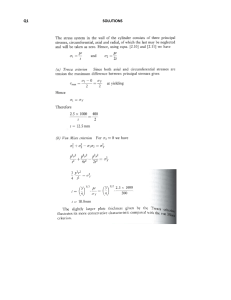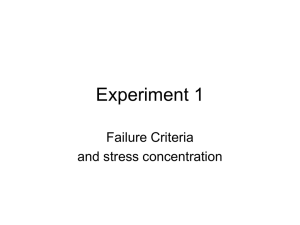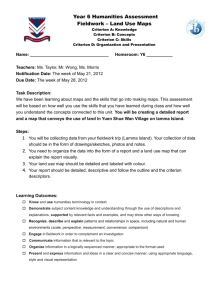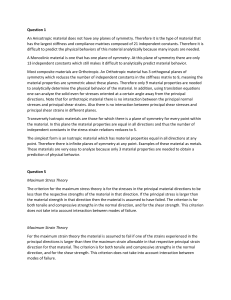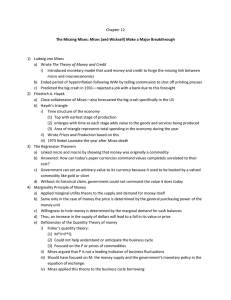Failure criteria for laminated composites
advertisement
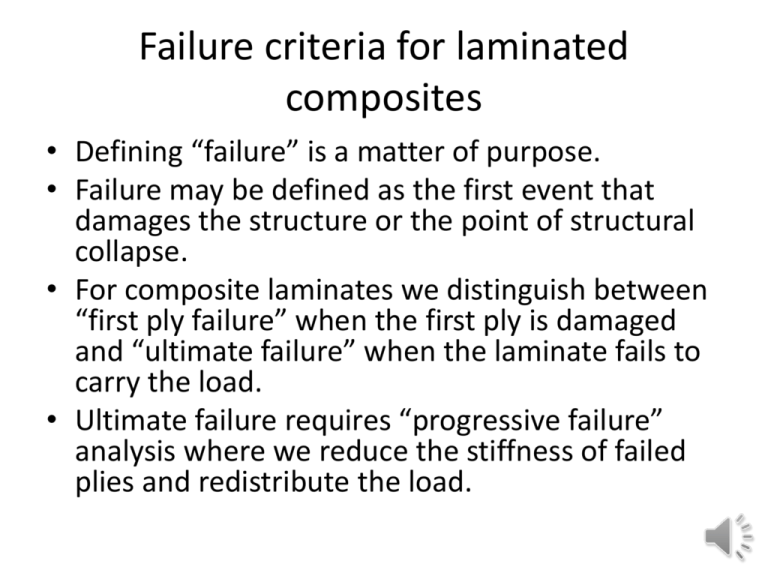
Failure criteria for laminated composites • Defining “failure” is a matter of purpose. • Failure may be defined as the first event that damages the structure or the point of structural collapse. • For composite laminates we distinguish between “first ply failure” when the first ply is damaged and “ultimate failure” when the laminate fails to carry the load. • Ultimate failure requires “progressive failure” analysis where we reduce the stiffness of failed plies and redistribute the load. Failure criteria for isotropic layers • Failure is yielding for ductile materials and fracture for brittle materials. • Every direction has same properties so we prefer to define the failure based on principal stresses. Why? • We will deal only with the plane stress condition, which will simplify the failure criteria. Then principal stresses are 2 1,2 x y 2 x y 2 2 xy • What about the third principal stress? Maximum normal stress criterion • For ductile materials strength is same in tension and compression so criterion for safety is S y 1, 2 S y • However, criterion is rarely suitable for ductile materials. • For brittle materials the ultimate limits are different in tension and compression Suc 1 , 2 Sut Maximum strain criterion • Similar to maximum normal stress criterion but applied to strain. • Applicable to brittle materials so tension and compression are different. uc 1 , 2 ut What is wrong with the figure? Maximum shear stress (Tresca) criterion • Henri Tresca (1814-1885) French ME • Material yields when maximum shear stress reaches the value attained in tensile test. • Maximum shear stress is one half of the difference between the maximum and minimum principal stress. • In simple tensile test it is one half of the applied stress. So criterion is 12 Sy 2 or 1 2 S y and 1 S y and 2 S y Distortional Energy (von Mises) criterion • Richard Edler von Mises (1883 Lviv, 1953 Boston). • Distortion energy (shape but not volume change) controls failure. • Safe condition Ud 1 1 2 2 2 2 Sy 1 2 2 3 3 1 6E 3E • For plane stress reduces to 12 1 2 22 S y2 Comparison between criteria • Largest differences when principal strains have opposite signs Maximum difference between Tresca and von Mises • Define stresses as 𝜎1 , 𝜎2 = 𝜎, 𝛼𝜎 . For what 𝛼 do we get the maximum ratio between the two predictions of critical value of 𝜎? Can assume |𝛼| ≤1. Why? 1. Positive 𝛼. Tresca gives 𝜎 = 𝑆𝑦 . Von Mises leads to 𝜎 2 (1 − 𝛼 + 𝛼 2 ) = 𝑆𝑦2 . Maximum for 𝛼=0.5, 𝜎 = 𝑆𝑦 0.75 = 1.155𝑆𝑦 2. Negative 𝛼. Tresca leads to 𝜎 1 − 𝛼 = 𝑆𝑦 . Von Mises still same equation. Maximum ratio for 𝛼=-1. 𝜎𝑇𝑟𝑒𝑠𝑐𝑎 = 0.5𝑆𝑦 , 𝜎𝑉𝑀 = 𝑆𝑦 • Check! 3



